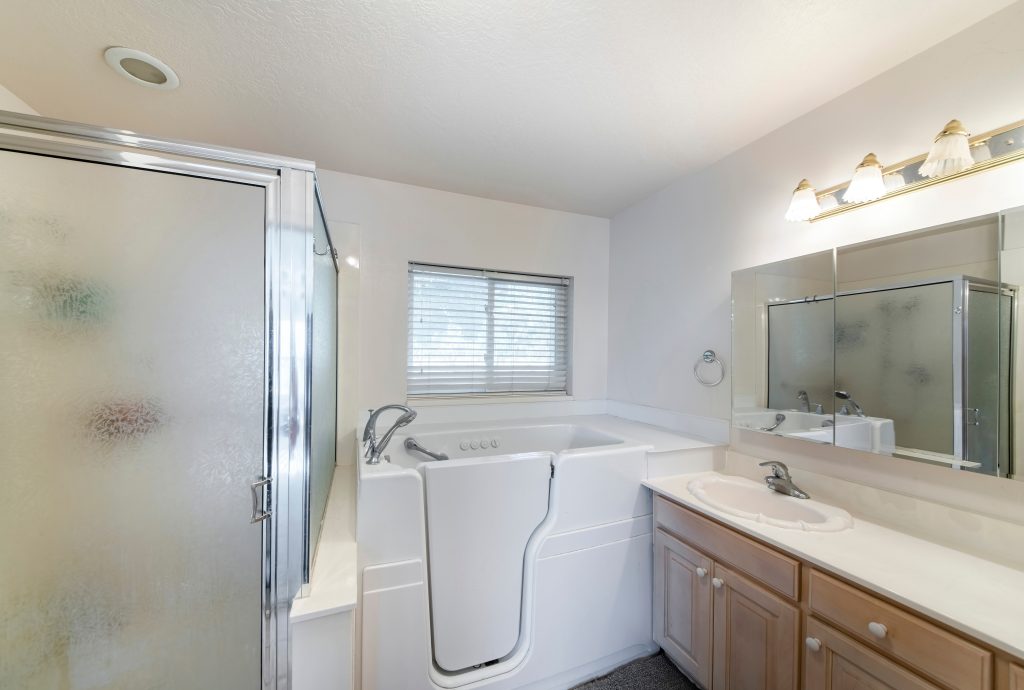Walk-In Tub Cost Guide

*Updated October 8th, 2024
What is a Walk-In Tub?
A walk-in tub provides a safer option for bathing if you or a family member has mobility issues or is older. Without a ledge to step over, there’s less risk of tripping and falling. In addition, the tubs have no lip and a door to get in and out of the tub.
You can fill up a walk-in tub after you’ve stepped in and closed the door. But, of course, you must also drain the tub before stepping out to avoid making a mess.
Walk-in tubs come with various features, including built-in showers, whirlpool jets, massage options, and safety bars.
Before installing a walk-in tub, it helps to understand how much you’ll need for a walk-in tub budget.
What is the Average Cost to Install a Walk-in Tub?
Like any new home appliance, the cost of a walk-in tub can vary drastically, but the average cost is $2,500 – $8,000.
Fortunately, there is financing available for most tub purchases if you don’t want to pay it in full upfront. However, the total cost varies based on the type of tub chosen and the necessary labor. For example, the labor will be more complex if there isn’t existing plumbing or electricity where you will install the tub.
Types of Tubs
There are many types of walk-in tubs. The one you choose should fit your walk-in tub budget and intended use.
Here are a few of the common tub types.
1. Standard Walk-In Tub
A standard walk-in tub is the most cost-effective; however, it has no upgrades or special features. Instead, they fit where the traditional tub was or would be and don’t require extensive plumbing or electrical work.
2. Tub/Shower Combos
If you have limited room in your bathroom, you may consider a walk-in tub/shower combo. As the name suggests, this option includes the tub and shower in one, but with only a small lip to step over for the tub.
Most tub/shower combos have shower curtains, but some have acrylic walls built around them for ease of use and aesthetic appeal.
3. Bariatric Walk-In Tubs
Bariatric tubs suit users that weigh 300 – 600 pounds. They are larger than the typical tub, and the door opening is wider to make it easier to get in and out of the tub. Bariatric tubs hold people of higher weight safely and have wider seats for more comfort.
Installing a bariatric tub may require extensive labor because of its larger size. In addition, you may need bathroom remodeling to make room for the tub. You may also need professional plumbing or electric work to ensure the tub works.
4. Soaker Walk-In Tubs
Traditional walk-in tubs are for sitting and bathing but not submerging yourself under the water. If you need a bathtub that submerges your body up to your shoulders, you prefer a hydromassage tub, you’ll need a soaker tub.
Soaker tubs are the traditional tub size but are deeper to allow them to hold more water. Soaker tubs are great for the entire family and can get more use.
5. Wheelchair Accessible Tubs
Wheelchair-accessible tubs have wider openings to allow a wheelchair into the tub/shower. In addition, these tubs usually have seats for those who can transfer from the wheelchair to the seat or room for a shower-resistant wheelchair.
Wheelchair-accessible tubs usually have grab bars and slip-resistant floors to ensure the safety of everyone using them.
What Affects a Walk-In Tub’s Cost?
As you consider your walk-in tub budget, consider these factors that affect a walk-in tub’s cost.
1. Labor Costs to Renovate the Bathroom
If you choose a walk-in tub that isn’t the standard tub size of 60” x 30” x 32”, you may need to pay for renovations, such as drywall, new fixtures, moving cabinets, and moving electrical work. In addition, if the tub is in a new spot, you may also need extensive plumbing work.
2. Upgrades to the Plumbing or Electrical
Even if you keep your tub in the same spot and it fits where the old tub was, you may need more extensive plumbing or electrical work if you upgrade the tub. For example, if you add whirlpool jets or hydro massage, you may need more extensive electrical work than exists in the spot currently.
3. Larger Water Heater
If your current water heater can’t keep up with the walk-in tub’s larger water capacity, you may need a larger water heater. You’ll typically need at least a 50+ gallon water tank, and newer tanks usually work better.
4. Old Tub Removal
If you aren’t removing the old tub yourself, you may have to pay for the removal of the old tub, which can increase the cost of installing your walk-in tub.
5. Type and Style
Different models offer various features and styles, such as soaking tubs, hydrotherapy options, or shower-tub combos. More specialized or luxury models tend to be more expensive.
6. Material
The materials used in the construction of the tub, such as acrylic or fiberglass, can impact the overall cost. Higher-quality materials often come with a higher price tag but may offer better durability and insulation.
7. Features and Accessories
Additional features like hydrotherapy jets, heated seats, grab bars, quick drain systems, and customizable options can increase the price. The more features included, the higher the overall cost.
Popular Features for Walk-In Tubs
Walk-in tubs themselves are amazing, but there are additional features you may want to consider.
1. Massage Jets
If you are installing a walk-in tub for mobility issues, adding massage jets may help alleviate some of your pain and keep your body looser. However, you’ll need a higher walk-in tub budget to cover the cost of the jets, and the cost increases the more jets you want or if you require custom placement of them.
2. Faster Drain Capabilities
You must drain a walk-in tub before opening the door, which can be a pain, especially if it’s cold. However, you may be able to pay for faster draining with a larger drain and sometimes wider pipes. If wider pipes are necessary, it can greatly increase your walk-in tub budget.
3. Handheld Shower
If you plan to use the tub as a shower, a removable/handheld shower wand can make the tub more accessible. It’s not too pricey to add a removable shower wand, and it can greatly enhance your shower’s accessibility.
4. Safety Bars
Safety bars or grab bars aren’t expensive to add to the tub. Most walk-in tubs come with at least one, but if you need a larger bar or an extra one, they add less than $100 to your costs.
5. Tub Seats
If you need a tub seat or bench, or a customized area for a wheelchair, it can add to your tub’s costs. You can even consider a heated bench to keep you warm while you sit in the tub. Of course, this adds to the cost but can be figured into your walk-in tub budget.
6. Illumination Features
LED lighting or built-in night lights can improve visibility and safety during evening baths.
7. Anti-Slip Flooring
Many walk-in tubs come with anti-slip surfaces to reduce the risk of slipping while getting in and out or during a bath.
8. Heated Backrest
A heated backrest offers added comfort, making bath time more enjoyable, especially in colder climates.
9. Water Temperature Control
Temperature control features allow users to set and maintain their desired water temperature, enhancing safety and comfort.
Are Walk-in Tubs Worth It?
When considering if walk-in tubs are worth it, you must consider why you need one. For example, if you have accessibility issues, including living in a wheelchair, are aging in place, or worry about falling when getting in the tub, they can be worth it.
If you’re on a limited budget, you can get a basic walk-in tub that fits the standard tub size without too many bells and whistles for around the same cost as a standard tub. It can make your home more accessible and allow you to continue to age in place versus moving into an assisted living or retirement home.
Alternatives to Walk-In Tubs
If you don’t have an adequate walk-in tub budget, other options exist to help you make your shower and/or tub safe.
- Shower chair
A shower chair sits safely in the shower, allowing you to sit while you shower. They have four legs and often have a cushioned (waterproof) seat for comfort.
- Transfer bench
A bath or shower transfer bench makes getting in and out of a tub easier. You sit on the bench and can safely swing your legs over the tub, so you don’t have to worry about slipping while exiting the tub.
- Rolling shower chair
A rolling shower chair is like a wheelchair, but it’s waterproof. You can roll in and out of the shower, so you don’t have to stand up and risk slipping and falling.
- Medical alert system
A medical alert system won’t stop you from slipping and falling, but if you do, you can immediately press the alert and have emergency help. This is especially important if you live alone or don’t have a walk-in tub.
FAQs
Is it cheaper to do a walk-in shower or tub?
A walk-in tub is usually cheaper than a walk-in shower and a tub. The average cost of a walk-in shower is $3,121 to $6,641, and the average cost of a walk-in tub is $2,500 – $8,000. So if you’re looking at the basic option for each, a shower may be less expensive. However, if you need more features, either one could be costly.
Is a walk-in tub tax deductible?
You may be able to include the cost of installing a walk-in tub in your deductible medical expenses if you can prove you installed it for medical or safety reasons. Talk with your tax advisor to determine your eligibility for this deduction.
Does a walk-in tub hurt your home’s resale value?
A walk-in tub can help your home’s resale value in the right market. First, think of the target audience in the area. Are they elderly, disabled, or likely to age in place? If so, having a walk-in tub can help your resale value. However, if the target audience is mostly younger buyers, a walk-in tub can lower the value in their eyes.
Final Thoughts
Like any home renovation, there are many considerations when determining your walk-in tub budget. First, consider your needs, what you must prioritize, and the room you have for the tub. Next, determine your budget and see if a walk-in tub with the necessary features fits it.
Additional Walk-In Tub Resources
- 10 Walk-In Tub Advantages
- Walk-In Tub Accessories
- The Importance of Safety Features on Your New Walk-In Tub

Anna has over six years of experience in the home services and journalism industries and serves as the Content Manager at MyHomePros.com, specializing in making complex home improvement topics like HVAC, roofing, and plumbing accessible to all. With a bachelor’s degree in journalism from Auburn University, she excels in crafting localized, comprehensive guides that cater to homeowners’ unique needs. Living on both coasts of the United States has equipped her with a distinctive perspective, fueling her passion for turning any house into a cherished home through informed, personalized decision-making.
Connect with top-rated local contractors who can help you with siding, roofing, HVAC, windows, and more. Get free quotes from verified professionals in your area today.








